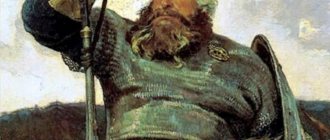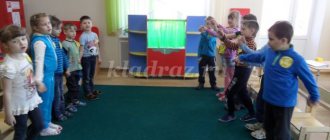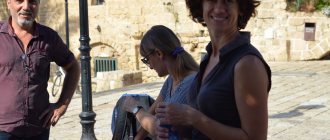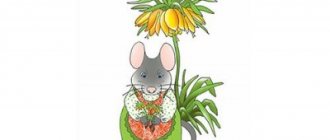Project “Heroes of the Russian Land”
- September 7, 2020
Competition "Children's Project - 2013"
Nomination "First Discoveries"
Having once seen a reproduction of the painting “Bogatyrs” by V.M. Vasnetsov, I wanted to know more about the defenders of the Russian Land, its faithful guardians. I began to ask adults to read me fairy tales and epics telling about the life of our ancestors. This is how I completely immersed myself in the atmosphere of Russian folk epic and its inhabitants. And I would really like to share the knowledge I have gained with you.
The purpose of our research: to get acquainted with Russian heroes through epics.
Tasks:
1) develop ideas about epic heroes - Ilya Muromets, Dobrynya Nikitich and Alyosha Popovich;
2) get acquainted with the weapons of heroes;
3) feel involved in the history of the Russian people.
Object: heroes.
Subject: the role of epics as a source of knowledge about Russian heroes.
Hypothesis: if we create an atmosphere of interest in the epic epic, if we evoke a positive emotional attitude towards it, then we will be able to awaken a sense of involvement in the history of our people.
Our acquaintance with oral folk art began with reading such epics as “Ilya Muromets and the Nightingale the Robber”, “Finist - Clear Falcon”, “Nikita Kozhemyaka”, “Alyosha Popovich and Tugarin the Serpent”. After the reading there was a conversation on the content of the epic.
For example, after reading such a work as “Ilya Muromets,” we learned a lot about the life of this hero. Ilya Muromets was a peasant son. He was born in the village of Karacharovo, near Murom. Until the age of 33, he could not walk, as he was paralyzed, but subsequently received miraculous healing from the elders.
To get closer to the life of the Russian people, we also learned poems, proverbs and sayings about work, friendship and courage. The cartoons we watched about the heroes of the Russian Land left pleasant impressions.
The exploits of Russian heroes are reflected not only in epics, but also in the works of artists. So, in the visual arts classes we got acquainted with the painting by V.M. Vasnetsov "Bogatyrs".
We applied the knowledge gained in our drawings on the following topics: “Portrait of a hero”, “Weapon of a hero”, etc.
The holiday for Defender of the Fatherland Day was also dedicated to heroic themes. The boys happily showed the dance of the heroes, previously learned with the choreographer, to the song “Our Heroic Strength” by A.N. Pakhmutova. At the matinee there were many games and fun, where the children showed themselves as dexterous and brave defenders.
The open lesson “Heroes of the Russian Land” can be considered a summary of our chosen topic. The children read a lot of poems about the Russian hero, shared their knowledge about the military exploits of Ilya Muromets, Dobrynya Nikitich and Alyosha Popovich. Afterwards we all went on a journey, where obstacles awaited us from the Serpent Gorynych. But we overcame them without difficulty. The last stage on the path to the “cherished” heroes was the game “Ancient and Modern Weapons”. Here we also proved ourselves to be erudite guys who know the weapons needs of Russian soldiers.
After the victory over Zmey Gorynych, we met a guslar boy who told us about the exploits of Russian heroes. Next we met three heroes. Ilya Muromets spoke about the Nightingale the Robber, from whose whistle “all the flowers fell off.” But Ilya defeated the evil bird. Dobrynya Nikitich told us about his victory over the Serpent Gorynych, and Alyosha Popovich - over the Tugarin Serpent. The heroes were well armed and always ready to help those in need. After all the stories, they bowed to us and left.
Conclusion. While working on the project “Heroes of the Russian Land,” we became acquainted with many works of literature and painting, learned a large number of poems and sayings, became interested in epic works, and most importantly, felt our involvement in the history of the Russian people. For many children, the Russian hero is now an example to follow in their lives.
Appendix 1. Video presentation
Appendix 2. Project.
Author: Nikita Vidanov, 6 years old, student of MBDOU No. 8 “Aistenok”, Michurinsk, Tambov region. Head: Anna Valerievna Protasova, teacher at MBDOU No. 8 “Aistenok”, Michurinsk, Tambov region.
Cartoons
A cartoon is a model of the world around us, so children tend to imitate what they see on the screen. We live in a century of new technologies, and accordingly, cartoons have become completely different. What kind of modern cartoons are they? What do they bring into our lives, what do they teach us?
Is it possible and worth watching all cartoons without restrictions? Why do parents allow me to watch some cartoons, and watch them with pleasure, while others don’t, even if they have such bright, colorful and cheerful characters. All children are literally in captivity of the animation. Many children and teenagers refuse to play, walk in the fresh air and communicate with friends, preferring to sit for hours in front of the TV.
What attracts teachers and parents to Soviet cartoons? Cartoons are a real find: as we know, for the most part they teach a child kindness, sincerity, devotion, the ability to value friendship and other qualities important for the harmonious development of a person. The high value of the “right” act, the idealization of honesty, spirituality, morality - all those qualities that each of us wants to instill in our children.
What are "epics"?
While studying the concept of “epics” on the Internet, I found that epics are Russian folk songs that tell about the heroic deeds of courageous heroes. They often describe heroic events and exploits in which the people took part. The word “epic” means “old times,” that is, something that happened far in the past. The epic as a literary genre is not subject to reliable accuracy.
Epics tell about invincible Russian heroes - and this is also true. Glorifying the heroes, the defenders of the Motherland, the epics called for heroic deeds for the glory of the fatherland, raised the spirit of the people in difficult years of trials, and instilled in their youth love for their native land and hatred for their enemies. The example of invincible heroes instills courage in people, strengthens the sense of duty and honor. There is not a single epic where the hero, a warrior, did not defeat the enemy.
There were a large number of heroes in Rus'. Some were more famous, others less famous. Some were made into films and series of cartoons, while others I only read about in books, and even then in very small stories. I decided to explore the life of three heroes. Two little-known ones, such as Mikula Seljaninovich and Churilo Plenkovic. And one powerful hero about whom legends were made - Ilya Muromets.
They were separated by centuries - Mikula Selyaninovich lived in the 9th century, Ilya Muromets in the 12th century, and Churilo Plenkovich in the 15th century. But when legends are passed down from one generation to another for centuries, they acquire new details, famous characters begin to perform new feats, and time frames gradually blur and shift.
WARRIOR
The image of a female hero is unusual for Russian epics. On the one hand, life in Ancient Rus' inevitably required both strength and ingenuity from the fair sex. On the other hand, the society was rather patriarchal. Therefore, heroic battles and brave deeds were considered more the lot of men than women. However, either as an inheritance from the once existing matriarchal communities, or as a sign of respect for the Russian Maryas and Vasilises, in the Slavic epic you can find several bright heroines who travel around the world to gain military strength for themselves.
Moreover, they have such heroic power that even great warriors do not always manage to cope with them. One of the most striking examples is Nastasya Mikulishna.
Images of heroes
Alesha Popovich
The Russian hero Alyosha Popovich is the youngest in the trinity of himself, Ilya Muromets and Dobrynya Nikitich. He was also a hero of the epics of the ancient Slavs. According to some sources, Alyosha is mentioned in more than fifty epics. But there are two main ones, where he acts as the main character. Epics about Alyosha Popovich for the Kyiv cycle.
In the epics, Alyosha is not described as a hero with extraordinary strength. Quite the contrary - he is weak and limps. But God gifted him with ingenuity, cunning, and intelligence. Alyosha Popovich played the gusli well. He could deceive, he could brag and do things on the sly. His jokes could be funny, or they could be evil. In general, Alyosha Popovich is a very contradictory character: sometimes insidious and arrogant, sometimes kind and merciful.
Bogatyr Alyosha Popovich has an interesting biography. His homeland was Rostov. When the hero Alyosha Popovich was born, thunder roared. While still a baby, he asks his mother to be swaddled not with films, but with chain mail.
Alyosha Popovich is a character in the cartoon “Three Heroes” and the epics “Alyosha Popovich and Tugarin the Serpent”, “Alyosha Popovich and the Zdrodovich Sister”, “Dobrynya at his wife’s wedding”, “Dobrynya and the Serpent”.
In the epics, Alyosha Popovich is distinguished not by strength, but by ingenuity and even cunning. In the cartoon, the hero is shown to us as straightforward and dashing, solving all issues with his fists. His “trademark” phrase is mentioned in every cartoon about the adventures of the three heroes: “Taste the heroic strength!” Probably, the directors imagined this character more comically in this image.
Alyosha Popovich has a wife. She is a character in both the epic and the cartoon.
In the epic she is Alyonushka. Their names are similar, thus forming a “eponymous” pair. And in the cartoon she is Lyubava. Probably, the name Lyubava was chosen as more “epic” and less “hackneyed”.
The heroic horse is a completely new invention! In epics it’s just a good means of transportation, but in a cartoon, in my opinion, it’s the central character: a talking horse that’s always “clever.”
In general, it can be noted that the authors of the cartoon added a huge amount of unusual humor to the heroism and patriotism of the epic heroes and “modernized” the characters in a very original way. Which made the story about the three heroes even more interesting and kind.
Nikitich
Dobrynya Nikitich is the second most popular hero of the Russian folk epic after Ilya Muromets. The hero is smart, educated and distinguished by a variety of talents: he is dexterous, savvy, quick on his feet, an excellent shooter, swims, plays tavlei, sings and, to boot, plays the harp. The epics about Dobrynya Nikitich are based on historical references to a relative of Prince Vladimir, a courageous hero - the governor.
Dobrynya is the hero closest to the prince and his family, carrying out their personal assignments and distinguished not only by his courage, but also by his diplomatic abilities, and therefore he is often depicted as a serving hero under Prince Vladimir, whose wife is Nastasya, the daughter of Mikula Selyaninovich.
Epics often talk about his long court service, in which he showed his qualities. Often the prince gives him instructions: to collect and transport tribute, to help out the prince’s niece, etc., but often Dobrynya himself volunteers to carry out the assignment that other heroes refuse.
Dobrynya is sometimes called the prince, and sometimes the nephew of Vladimir the Red Sun. According to the epics, Dobrynya Nikitich is the son of the Ryazan governor Nikita, he himself is smart, educated and distinguished by a variety of talents: he is dexterous, savvy, strong, fair, quick on his feet, kind-hearted, an excellent shooter, swims, plays tavlei, sings, and In addition, he plays the harp.
The image of Dobrynya is outlined clearly and definitely in epics. He has courage and enormous physical strength, and at the same time he is distinguished by courtesy and diplomacy and could speak “in 12 languages and knew the conversation of birds.”
According to S.N. Azbelev, who counts 53 plots of heroic epics, Dobrynya Nikitich is the main character of six of them.
One of them:
- Dobrynya's duel with Ilya Muromets
- Dobrynya and the Serpent (but he not only fights with the Serpent, but also frees Prince Vladimir’s niece Zabava Putyatichna from captivity)
- Dobrynya and Marinka
- Dobrynya and Nastasya
- Dobrynya and Alyosha (“Dobrynya is away”, “Dobrynya at his wife’s wedding”)
- Dobrynya and Vasily Kazimirovich
For some stories, the number of individual versions recorded from different storytellers amounts to dozens. Dobrynya Nikitich plays an important role in the epics about the Danube.
- Duel between Danube Ivanovich and Dobrynya Nikitich
- Danube Ivanovich - matchmaker (Danube and Dobrynya rescue the bride for Prince Vladimir)
Comparison of epics and cartoons
| Text of the epic | Cartoon |
| There is no mention of the battle of Dobrynya with the Mongol-Tatars | There is a fragment of the battle between Dobrynya and the Mongol-Tatars |
| After kidnapping Zabava, the snake Gorynych takes her to his lair | After kidnapping Zabava, Zmey Gorynych gives her to the merchant Kolyvan |
| The kidnapping of his niece is a complete surprise for the prince | Prince Vladimir makes a deal with the merchant and allows the Zabava to be stolen |
| Dobrynya saves Zabava alone | Together with Dobrynya, the messenger Elisha goes to save Zabava Putyatichna. |
| The snake is the sworn enemy of the hero | At the end of the film, Zmey Gorynych helps Dobrynya |
| Ends with Zabava's rescue | Ends with the wedding of Elisha and Zabava |
For the Russian people, Dobrynya Nikitich is an example of courage and bravery. His exploits are an example of love for his land and compatriots.
Ilya Muromets
Ilya Muromets is a Russian folk hero, known to us because he was born in the ancient city of Murom and sat on a stove for thirty years. We also know from epics that after wanderers visited his house, he gained heroic strength...
In the epics we see Ilya Muromets as brave, courageous... He shows not only courage and bravery, but also ingenuity and military cunning.
In the series of animated films “Three Bogatyrs,” Ilya Muromets is the wisest of the three heroes and leads the other heroes.
Ilya has a faithful horse, Burushka, whom he loves dearly and is ready to fight with anyone who dares to offend the horse.
The story of Burushka from the epics, which was also taken into the storyline of the cartoon:
“Ilya went to an open field in the expanse of land, and saw: a man was leading an unwise stallion, a shaggy brown stallion. Ilya bought the stallion, What the man asked for, he gave; He put the stallion in a log house for three months, fed him white millet, and gave him fresh spring water to drink. And three months passed. Ilya began to caress the stallion in the garden for three nights, and rolled him out at three dews; He brought him to a high tine, and began to jump over the tine, both in this direction and in the other direction. Here Ilya Muromets
I saddled a good horse, bridled ... "
At home, Ilya’s faithful wife Nastasya is waiting.
Ilya Muromets has a similar appearance both in epics and in cartoons.
In my opinion, the appearance of the hero is very similar to the painting “Three Bogatyrs”.
SISTERS AND PLOT RIDDLES
Nastasya Mikulishna and Vasilisa Mikulishna are woodpile sisters, two bright female images of Russian epics. However (as in the case of male characters), despite family ties, each of the maidens has its own characteristics. Moreover, it is in the example of this couple that we can see two completely opposite heroines - perhaps due to the fact that the qualities of the sisters are contrasting. If Vasilisa is famous, rather, for her feminine cunning and ingenuity, then Nastasya is closer to the classic image of a hero. She has incredible power, not inferior to the good fellows of the epic, and some witchcraft spells. It is possible that they are the source of its irresistible power.
Due to the fact that there are not many epic stories about Nastasya Mikulishna, we can only guess what role the hero was assigned in the Russian epic. It is possible that due to its origin from the Mother of the Raw Earth, the woodpile was her earthly embodiment. That is why Nastasya is irresistible, even the most powerful hero in her hands becomes no stronger than a small child.
It is surprising that the epics dedicated to Nastasya Mikulishna do not describe the feats or military accomplishments of the heroine, but clearly, emphasizing the strength and power of the heroine, assign her only the role of Dobrynya Nikitich’s wife. Perhaps other legends simply have not survived to this day. There is a well-known epic about how Nastasya’s sister Vasilisa outwitted the Prince of Kyiv. The conclusion could be this: no matter how strong a woman is, her place is still next to her husband, and not on the battlefield.
It would seem, what did it cost Nastasya, who defeated even Dobrynya, to stand up for her honor when they began to persuade the girl to marry Alyosha Popovich? Nevertheless, according to the plot, the woodpile is assigned the role of a submissive prude until the appearance of her liberator. Perhaps this is how Russian legends reflected the transition from matriarchy to patriarchy - a change in traditions, consolidated by epics that were passed on from mouth to mouth, from generation to generation.






